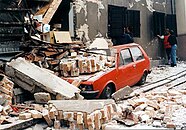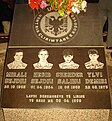
Kosovo War
1998–1999 armed conflict in Kosovo / From Wikipedia, the free encyclopedia
Dear Wikiwand AI, let's keep it short by simply answering these key questions:
Can you list the top facts and stats about Kosovo War?
Summarize this article for a 10 year old
The Kosovo War (Albanian: Lufta e Kosovës; Serbian: Косовски рат, Kosovski rat) was an armed conflict in Kosovo that lasted from 28 February 1998 until 11 June 1999.[57][58][59] It was fought between the forces of the Federal Republic of Yugoslavia (i.e. Serbia and Montenegro), which controlled Kosovo before the war, and the Kosovo Albanian separatist militia known as the Kosovo Liberation Army (KLA). The conflict ended when the North Atlantic Treaty Organization (NATO) intervened by beginning air strikes in March 1999 which resulted in Yugoslav forces withdrawing from Kosovo.
| Kosovo War | |||||||||
|---|---|---|---|---|---|---|---|---|---|
| Part of the Yugoslav Wars[1] | |||||||||
| Clockwise from top left: Yugoslav general staff headquarters damaged by NATO air strikes; a Zastava Koral buried under rubble caused by NATO air strikes; Kosovo Force soldiers near the Kosovo-Macedonia border; a USAF F-15E taking off from Aviano Air Base; memorial to local KLA commanders | |||||||||
| |||||||||
| Belligerents | |||||||||
|
|
| ||||||||
| Commanders and leaders | |||||||||
|
| |||||||||
| Strength | |||||||||
|
|
| ||||||||
| Casualties and losses | |||||||||
|
| ||||||||
|
8,676 Kosovar Albanian civilians killed or missing[30] Aftermath 113,128[55] to 200,000+ Kosovo Serbs, Romani, and other non-Albanian civilians displaced[56] | |||||||||
The KLA was formed in the early 1990s to fight against the discrimination of ethnic Albanians and the repression of political dissent by the Serbian authorities, which started after the suppression of Kosovo's autonomy by Serbian leader Slobodan Milošević in 1989.[60] The KLA initiated its first campaign in 1995, after Kosovo's case was left out of the Dayton Agreement and it had become clear that President Rugova's strategy of peaceful resistance had failed to bring Kosovo into the international agenda.[61] In June 1996, the group claimed responsibility for acts of sabotage targeting Kosovo police stations, during the Kosovo Insurgency.[62][63] In 1997, the organisation acquired a large quantity of arms through weapons smuggling from Albania, following a rebellion in which weapons were looted from the country's police and army posts. In early 1998, KLA attacks targeting Yugoslav authorities in Kosovo resulted in an increased presence of Serb paramilitaries and regular forces who subsequently began pursuing a campaign of retribution targeting KLA sympathisers and political opponents;[64] this campaign killed 1,500 to 2,000 civilians and KLA combatants, and had displaced 370,000 Kosovar Albanians by March 1999.[65][66]
On 20 March 1999, Yugoslav forces began a massive campaign of repression and expulsions of Kosovar Albanians following the withdrawal of the OSCE Kosovo Verification Mission (KVM) and the failure of the proposed Rambouillet Agreement.[65][67] In response to this, NATO intervened with an aerial bombing campaign that began on March 24, justifying it as a "humanitarian war".[68] The war ended with the Kumanovo Agreement, signed on 9 June 1999, with Yugoslav and Serb forces[69] agreeing to withdraw from Kosovo to make way for an international presence. NATO forces entered Kosovo on June 12.[70][71] The NATO bombing campaign has remained controversial.[72] It did not gain the approval of the UN Security Council and it caused at least 488 Yugoslav civilian deaths,[73] including substantial numbers of Kosovar refugees.[74][75][76]
In 2001, a UN administered Supreme Court based in Kosovo found that there had been a systematic campaign of terror, including murders, rapes, arsons and severe maltreatments against the Albanian population, but that Yugoslav troops had tried to force them out of Kosovo, but not to eradicate them, and therefore it was not genocide.[77] After the war, a list was compiled which documented that over 13,500 people were killed or went missing during the two year conflict.[78] The Yugoslav and Serb forces caused the displacement of between 1.2 million[79] and 1.45 million Kosovo Albanians.[80] After the war, around 200,000 Serbs, Romani, and other non-Albanians fled Kosovo and many of the remaining civilians were victims of abuse.[81][82][83]
The Kosovo Liberation Army disbanded soon after the end of the war, with some of its members going on to fight for the UÇPMB in the Preševo Valley[84] and others joining the National Liberation Army (NLA) and Albanian National Army (ANA) during the armed ethnic conflict in Macedonia,[85] while others went on to form the Kosovo Police.[86]
The International Criminal Tribunal for the former Yugoslavia (ICTY) convicted six Serb/Yugoslav officials and one Albanian commander for war crimes.




